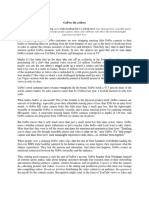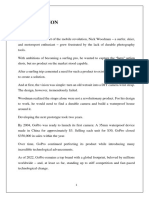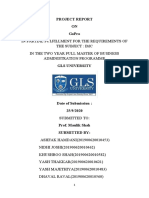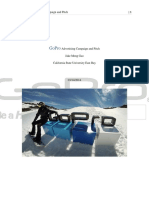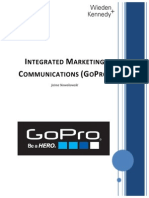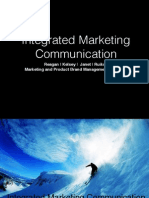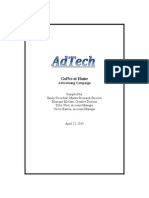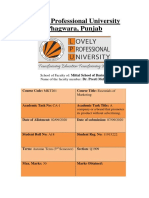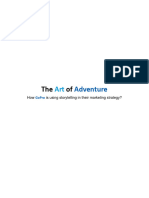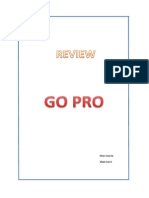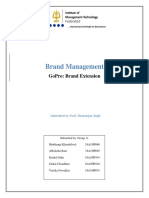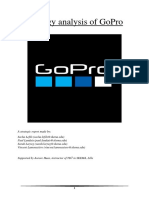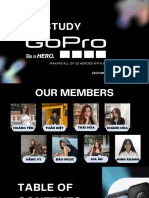0 ratings0% found this document useful (0 votes)
113 views37 pagesChap 8
Uploaded by
Hà LinhhCopyright
© © All Rights Reserved
We take content rights seriously. If you suspect this is your content, claim it here.
Available Formats
Download as PDF or read online on Scribd
0 ratings0% found this document useful (0 votes)
113 views37 pagesChap 8
Uploaded by
Hà LinhhCopyright
© © All Rights Reserved
We take content rights seriously. If you suspect this is your content, claim it here.
Available Formats
Download as PDF or read online on Scribd
You are on page 1/ 37
PART 1: Defining Marketing and the Marketing Process (Chapters 1-2)
Pre eee ea era)
PART 4: Extending Marketing (Chapters 18-20)
Products, Services, and Brands
Building Customer Value
‘Atter examining customer value-driven marketing
strategy, we now take @ deeper look at the marketing
imix: the tactical tools that marketers use to imple
ment their strategies, engage customers, and delver
‘superior customer value, In this and the next chapter,
we wil study how companies develop and manage products,
ssovvicas, and brands. Then, in the chaptors that folow, we look
at pricing, cistrbution, and marketing communication tools. The
product and brand are usually the frst ard most basic marketing
consideration, We start with a seemingly simple question: What is
a product? Asi tums out the answer is not so simple,
PREVIEWING
THE CONCEPTS
GOPRO: Be a HERO
rn ever-growing army of GoPro customers are now
strapping amazing little GoPro cameras to their
bodies or mounting them on anything from the
front bumpers of race cars to the heels of skydiving.
boots in order to capture the extreme moments of theit lives
and lifestyles. Then they can’t wait to share those emotion-
packed GoPro moments with friends. In fact, the chances
are good that you've seen many GoPro-created videos on
‘YouTube, Facebook, and Instagram or even on TV.
Maybe it’s the video shot by the skier who sets off
‘an avalanche in the Swiss Alps
‘and escapes by parachuting off 2
clif—that amateur video received
26 million YouTube views in nine
‘months. Or maybe you savy the one
‘where a seagull picks up a tourist's
‘camera and takes off with it, cap-
turing a bird's-eye view of a castle
Jn Cannes, France (3 million views
in seven months). Or what about
the video of the mountain biker in
‘Africa who is ambushed by a full-grown gazelle (more than
133 million views in four months)? One video in which a tech-
challenged Irishman used his son’s GoPro to capture his entire
Las Vegas vacation with the camera mistakenly pointed at him-
self instead of the sights snared 6.9 million views in only six days.
in their lives.
Crete ee ee Ce
orareer ne enue
DUS Na Coe ke
pean Cone C Rc aed
Pee ee eon aa)
CUCU ecacced
‘To aig a ite deeper into the question of what is @ product,
we begin by looking at GoPro, You may never have heard of
GoPro, the fast-growing company that makes tiny, wearable HD
video cameras. Yet few brands can match the avid enthusiasm
and loyalty that GoPro has created in the hearts and minds of
Its customers. GoPro knows that, deep down, [is products are
much more than just durable Ile cameras. More than that, it
gives customers a way to share acton-charged moments and
‘omations with finds
GoPro's avid customers have become evangelists for the
brand, GoPro holds a 47.5 percent share of the action camera
market. Its sales soared to more than $14 billion last year,
a fivefold increase in only four years
What makes GoPro so successful? Part of the formula is
the physical product itsel GoPzo cameras are marvels of tech-
nology, especially given theie affordable starting price of less
than $200 for an entry-level model. A GoPro HD video camera
looks like little more than a small gray box. But the lightweight,
wearable or mountable GoPro is extremely versatile, and it
packs amazing power for captur-
ing stunning HD-quality video. A
removable housing makes GoPro
‘cameras waterproof to depths of
130 feet, And GoPro cameras are
rop-proof from 3,000 feet (50
You might also like
- Principles of Marketing 16th Edition Kotler Solutions Manual 1100% (66)Principles of Marketing 16th Edition Kotler Solutions Manual 136 pages
- Company Case: Gopro: From Hero To Zero and BackNo ratings yetCompany Case: Gopro: From Hero To Zero and Back3 pages
- GoPro: Capturing Life's Thrilling MomentsNo ratings yetGoPro: Capturing Life's Thrilling Moments10 pages
- Strategic Management Instructor: DR Tony Gibeily Student: Rabih Darwiche ID: 201910617 Fall 2020 - 2021No ratings yetStrategic Management Instructor: DR Tony Gibeily Student: Rabih Darwiche ID: 201910617 Fall 2020 - 202112 pages
- Go Pro The Complete Manual 2nd Ed - 2016 UKNo ratings yetGo Pro The Complete Manual 2nd Ed - 2016 UK132 pages
- GoPro's Paul Crandell Turns Us All Into Thrill Seekers - AdweekNo ratings yetGoPro's Paul Crandell Turns Us All Into Thrill Seekers - Adweek4 pages
- MAGAZINE Tricks and Tips - Outdoor Photography - Edition 2024No ratings yetMAGAZINE Tricks and Tips - Outdoor Photography - Edition 202489 pages
- Products, Services, and Brands-Building Customer Value PDFNo ratings yetProducts, Services, and Brands-Building Customer Value PDF52 pages
- Gopro For Beginners 4th Edition November 2020No ratings yetGopro For Beginners 4th Edition November 202078 pages

